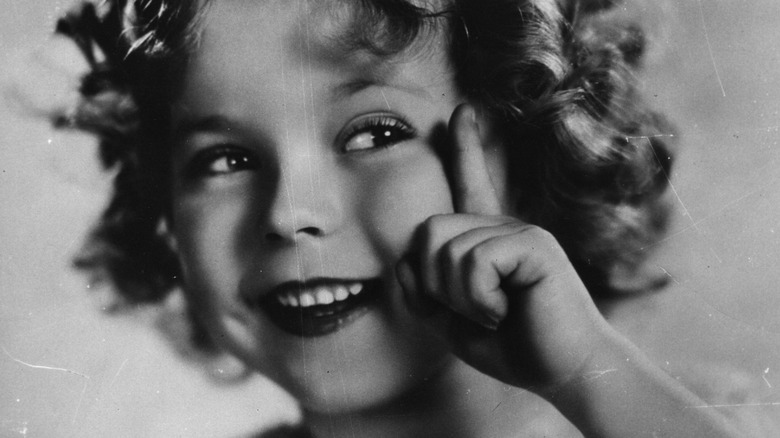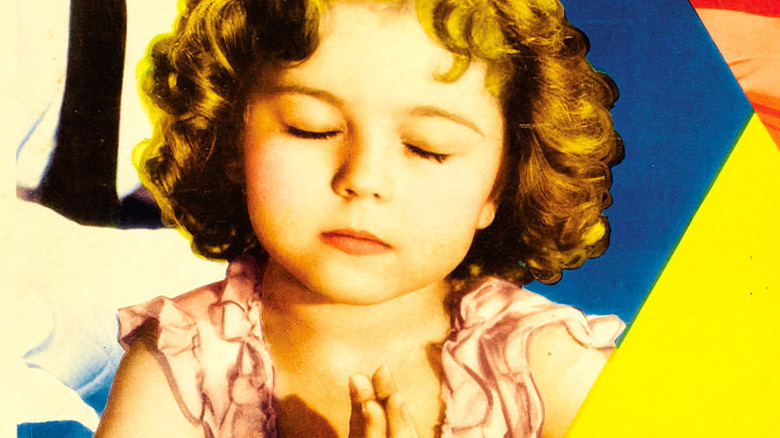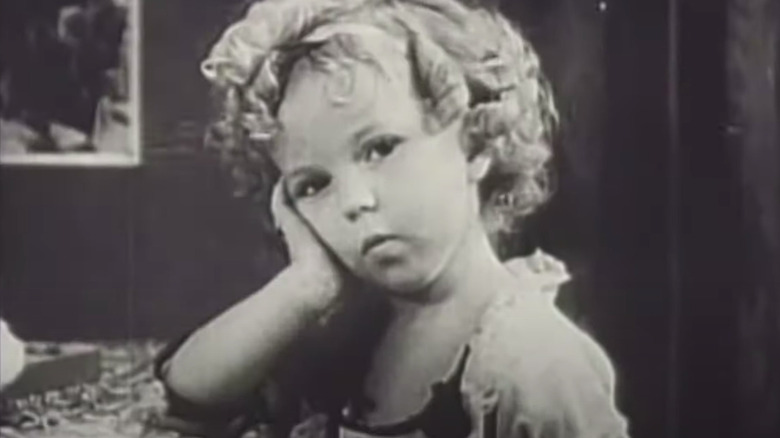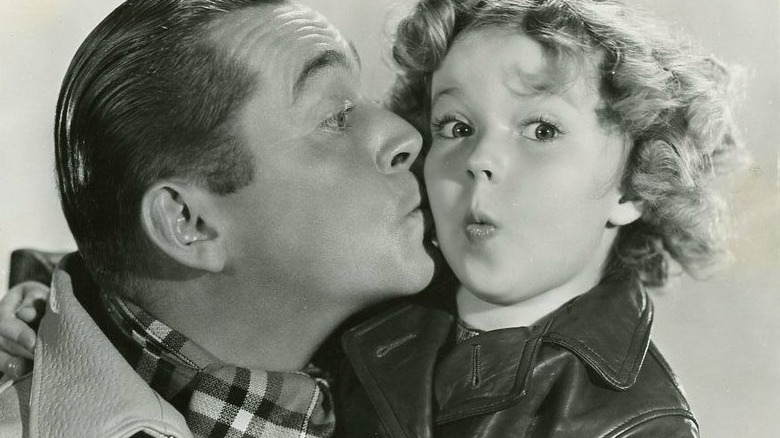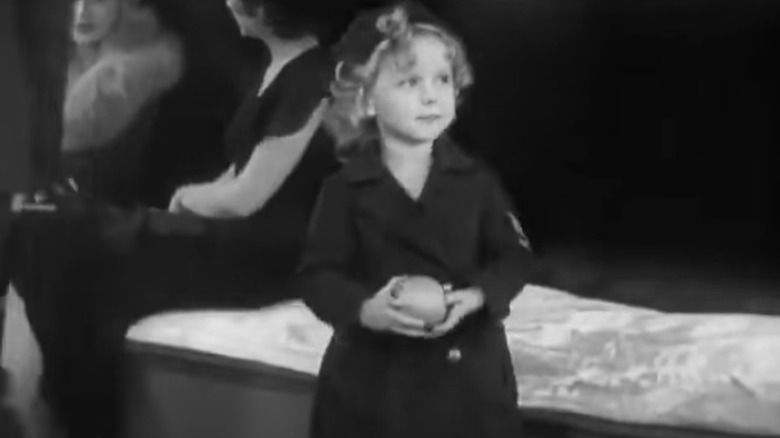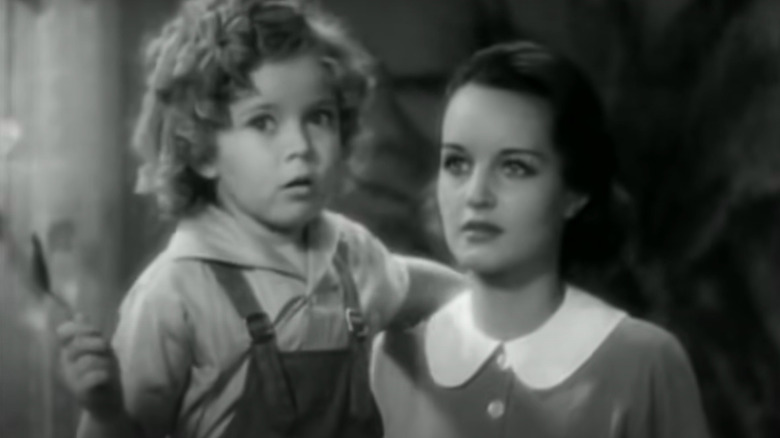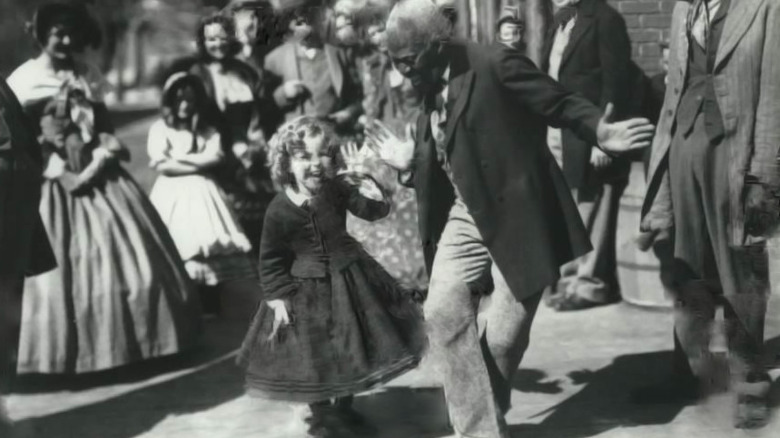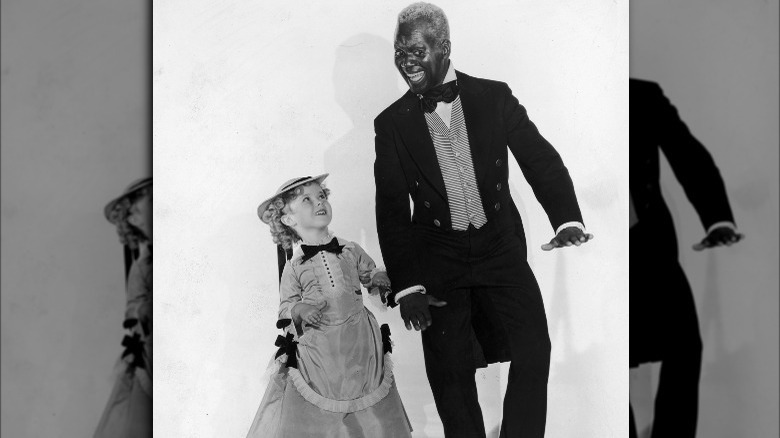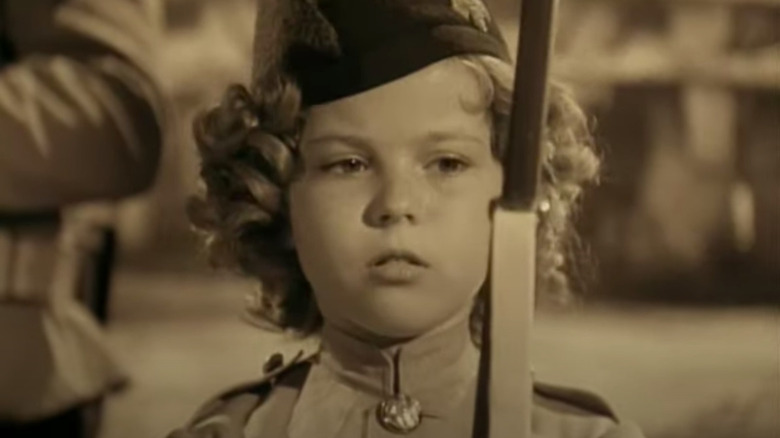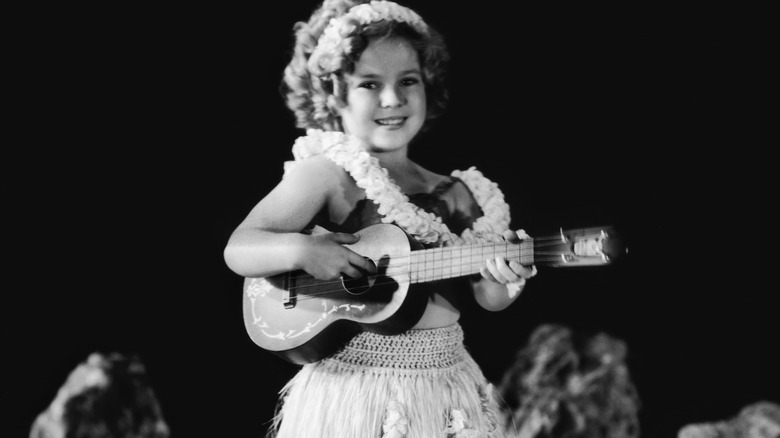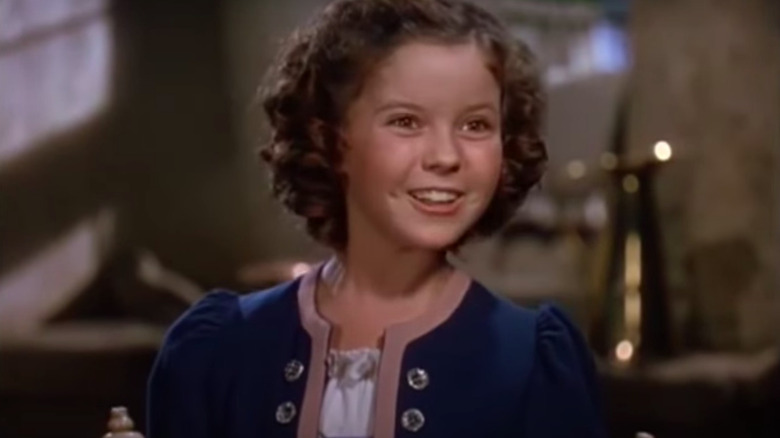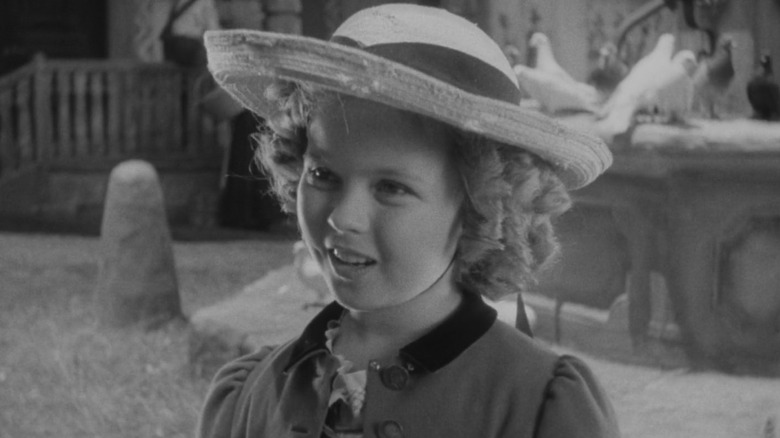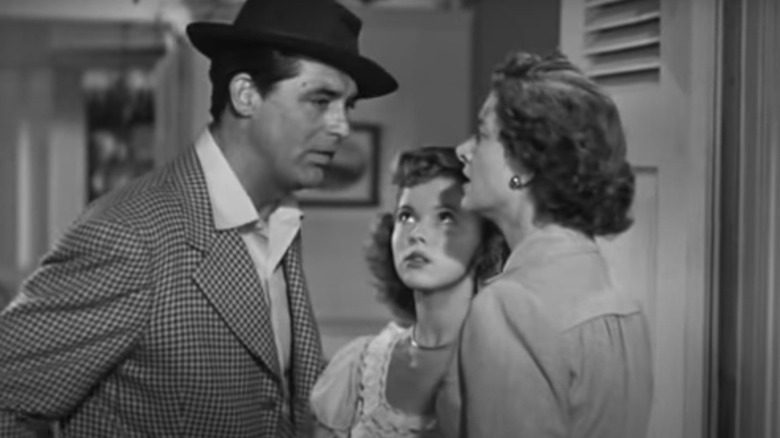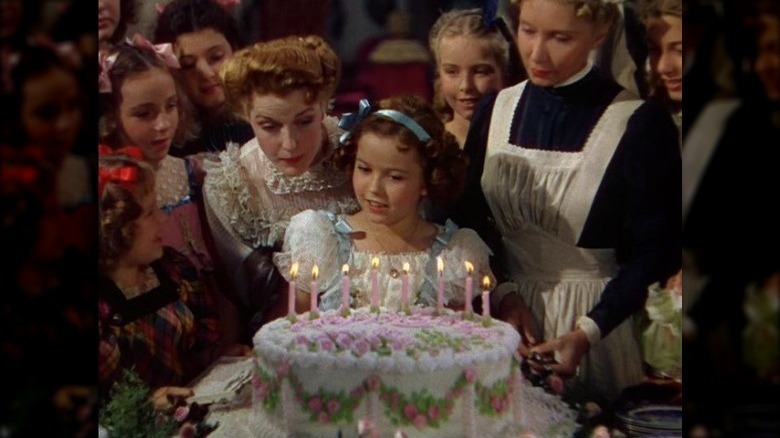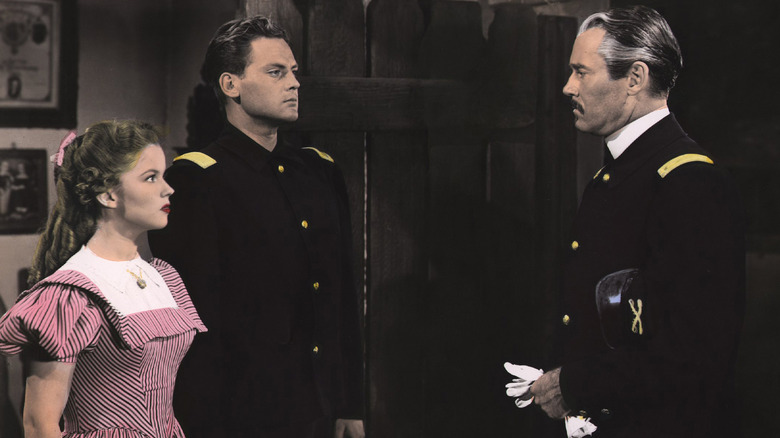Shirley Temple's 7 Best And 7 Worst Onscreen Roles
Historically, Shirley Temple's rapid ascent to the A-list of Hollywood made perfect sense. According to Biography, the legendary child star was born in 1928 in Santa Monica, California, and a mere three years later, her parents swiftly had her sign her first on-screen contract. By the time she was entering adulthood in her early 20s, she had starred in over 50 flicks — a true feat for any actor.
So, what caused such a Shirley Temple craze? The answer isn't anywhere close to being as cheery as her iconic entertaining: The Great Depression. Considering the economic downfall began in 1929 and ended around 1939 (via Britannica), Temple's debut in 1932 offered the escapism that the masses craved. Perhaps Franklin Roosevelt said it best in 1933, "It is a splendid thing that for just 15 cents an American can go to a movie and look at the smiling face of a baby and forget his troubles" (via The Washington Post).
Sure enough, that's exactly what Temple did, giggling, dancing, and exuding the sort of positivity that was only imaginable during this time thanks to a little bit of movie magic. Her catalog of films is vast, sure, but let's take a look at seven of the best and seven of the worst on-screen roles of Shirley Temple.
Hit: Little Miss Marker (1934)
Although Shirley Temple's mainstream Hollywood debut came by way of "Stand Up and Cheer!" in 1934, it's "Little Miss Marker" — which came out the same year — that really put her on the map. Boasting an impressive 100% on Rotten Tomatoes, the comedy sees Temple's character as an orphan suddenly found in the care of a racetrack worker who has no idea how to be a parent. Through various trials and tribulations, the once-hesitant bookie grows to love Temple's on-screen persona.
As a film essay for the Library of Congress points out, "Little Miss Marker" was perfect for the times. While the Great Depression was raging on in real life, the flick "showed how confidence and cheer could triumph over gloom and suspicion." What's more, it set the standard for all future box-office successes of Temple's: shoving her in a role of "a motherless, often completely orphaned but indomitably cheerful little girl who sings upbeat songs" and ultimately fixes whatever sort of dilemma her on-screen peers may be having. Simply put, audiences lapped up her enthusiastic persona.
Interestingly enough, Temple almost missed out on this important role. As she revealed in her biography, "Child Star," producers flat-out rejected her for the part initially, and it was only after her fame started to grow (and her mother's persistence), that she managed to land another audition, and, ultimately, get the role.
Miss: Baby Burlesks (1932-1933)
Out of Shirley Temple's entire filmography, the "Baby Burlesks" short films are probably the most cringe-worthy — mainly due to the ultra-unsettling content. The series of one-reel movies include 1932's "War Babies" and 1933's effort, "Glad Rags to Riches," and see toddlers acting in adult situations, such as the latter, which saw Temple taking on the role of a nightclub dancer.
"The films were a cynical exploitation of our childish innocence," recalled the actor decades later in her book, "Child Star," adding, "occasionally [they] were racist and sexist." At the time, however, the kids obviously didn't pick up on the certainly-not-G-rated content, and the result is truly bizarre. As Temple writes, "from the waist up, we were costumed as adults," yet "from the waist down," the cast was still wearing diapers.
While Temple certainly gained a modicum of experience on these film sets, the production value was, without a doubt, crude. She recalls each film taking about two days to shoot, while rehearsals themselves were a mere one week long. As for the pay? Temple wasn't making the big bucks just yet: she was only paid $10 a day — rehearsals not included.
Hit: Bright Eyes (1934)
Shirley Temple fans will immediately recognize her 1934 hit, "Bright Eyes," as it saw the tiny star singing what is now her most well-known bop to date: "On The Good Ship Lollipop." The premise for the flick is a Temple classic: the youngster loses her mother in an accident and suddenly finds herself orphaned, yet her infectious personality results in a custody battle between a pilot and a family who adopts her.
While the film itself performed quite well and solidified Temple as a major box office attraction in the '30s, it's her adorable song that got the most attention. "Those lyrics were an instant hit when I sang them," the actor recalled in her book, "Child Star." Claiming that 400,000 pieces of sheet music for the track were sold, Temple notes that she "[topped] the previous all-time records of crooner Bing Crosby and soprano Jeanette MacDonald."
If that wasn't enough, thanks to the routine in "Bright Eyes," Temple snagged her first Oscar — "a special Academy Award, for 'Outstanding Personality of 1934'" (via Biography).
Miss: Stand Up and Cheer! (1934)
While there is nothing explicitly bad about Shirley Temple's 1934 effort in "Stand Up and Cheer!," it was the first film that put the star on the map, so her talents weren't yet as refined as they would become. Although Temple had 11th billing in "Stand Up and Cheer!," she definitely made an impact on audiences. In fact, one review by The New York Times called her "a delightful child."
A typical Depression-era movie, "Stand Up and Cheer!" revolved around dance numbers bringing hope and joy to a wary country. As USA Today notes, the flick "inextricably linked Temple with [President Franklin D. Roosevelt], making her a poster child for the New Deal." Soon enough, FDR himself would dub Temple "Little Miss Miracle" for keeping America's morale high during The Great Depression (via Biography).
While audiences enjoyed watching Temple sing and dance, executives made sure to let the young actor and her mother both know she needed more practice in front of the camera. "My people say Shirley has potential," the star recalled Fox executive Winfield R. Sheehan telling Gertrude Temple (via "Child Star"). "Unfortunately, she needs a lot more training," Sheehan added, and just like that, Shirley's partnership with the iconic film company began.
Hit: Curly Top (1935)
By 1935, Temple had already completed seven big-screen acting gigs, and as such, began to wholly harness her talents. In fact, it's in 1935's family musical "Curly Top" that she really started to hone her cues and direction.
After the flick came out, a review by The New York Times praised that the musical "actually [hinted] in her work at an increased maturity of technique," noting Temple's impeccable "timing" and applauding her "assurance and precision of a veteran actress" when it came to more complex, dramatic scenes. In reality, this was probably due to her mom, Gertrude, extensively coaching the young star. As director of the movie, Irving Cummings, once shared (via Backstage), "Mrs. Temple is much more Shirley's director than I am. She teaches her her lines, coaches her on how to say them, suggests Shirley's expressions, shows her how to sit and stand and walk and talk and run."
In her biography, "Child Star," Shirley noted that she had, in fact, "faltered" during the filming of a particularly long monologue, causing Cummings to ask, "I thought you were One-Take Temple." There's no doubt that by the time "Curly Top" was released, Shirley Temple had grown to be an industry heavyweight professional.
Miss: The Littlest Rebel (1935)
Shirley Temple collaborated with tap dancer Bill "Bojangles" Robinson a total of four times during her reign as Hollywood's shining star, yet their 1935 effort, "The Littlest Rebel," stands out in hindsight for all the worst reasons. As "Blacks in American Films & Television: An Illustrated Encyclopedia" (via Louis Proyect) summarizes, the movie sees as a Civil War-era "Southern belle," whose father is taken "to a Yankee prison camp and her mother dies," leaving Robinson to ultimately save her "and dance with her."
Robinson was making fantastic money starring in such high-profile roles, and by 1937, his weekly earnings on film sets were unheard of for Black performers (via PBS). At the same time, "The Littlest Rebel" is now viewed as a complete miss for its problematic content, such as one scene which sees Temple "[going] in blackface" (via Louis Proyect). If that's not all, Film historian Donald Bogle told NPR that "that Robinson's character — a slave during the Civil War" was developed as a "clueless" character. "He has a moment when he's really asked about the war, and he seems completely befuddled, that he doesn't understand it."
In her book, "Child Star," Temple notes that the flick was an instant success, yet as Bogle tells the NPR, not everyone was pleased, with Black viewers unhappy at Robinson's "image" in the film.
Hit: The Little Colonel (1935)
The 1935 film "The Little Colonel" was Shirley Temple's first collaboration with tap dancer Bill "Bojangles" Robinson, and it was pretty groundbreaking at the time, too. According to the NPR, their now-iconic staircase tap-dancing scene was novel, as the duo was "the first interracial couple to dance onscreen" together.
Another important aspect of this flick is that Temple credits Robinson as being the one who taught her how to dance with ease. "We held hands and I learned to dance from Bill by listening, not looking at the feet," she told NPR decades later in the '80s. Temple elaborated more in her book, "Child Star," explaining the duo's adorable introduction, where, upon meeting, the young actor immediately reached for his hand to hold. From that day on, she called him "Uncle Billy," while the dancer sweetly referred to her as "Darlin'."
While the flick was a success, and Temple admits that learning to dance from Robinson gave her the "fondest memories," sadly, this movie doesn't exactly stand the test of time. As The New Yorker writes, "The plot of this movie is corny and unself-consciously racist," referencing "Mr. Bojangles: The Biography of Bill Robinson," where authors Jim Haskins and N. R. Mitgang both note that at the end of the day, Robinson's character still danced for the little girl "whenever she asked" (via The New Yorker).
Miss: Wee Willie Winkie (1937)
Out of Shirley Temple's overwhelmingly vast catalog of movies she made (58, to be exact), she recalled in her book, "Child Star," that 1937's "Wee Willie Winkie" was her favorite. Temple takes on the role of a young girl living with her grandfather and mother in northern India in the early 1900s, forming a bond with the army embroiled in war. "I rate 'Wee Willie Winkie' the best, but for all of the reasons," the actor writes, citing the prop guns, stunts, and general rowdy on-set buffoonery.
While "Wee Willie Winkie" may be Temple's fondest movie, audiences were quite divided, and it "stirred conflicting opinion," she explains. While this was partly due to "pro-England sentiments," there was also the troubling film review by Night and Day magazine, written by Graham Greene (via The Charnel-House). Dubbing Temple "a complete totsy," Greene writes, "watch the way she measures a man ... with dimpled depravity. Adult emotions of love and grief glissade across the mask of childhood, a childhood skin-deep."
While Greene's review may have left a brief sour taste in the mouths of his readers, Temple wouldn't back down. According to The Wall Street Journal, both Temple and Fox Studios sued Night and Day and ultimately shut down the magazine. As for Greene? He didn't have kind words for his nemesis, dubbing her "that little b**ch Shirley Temple" (via "Child Star).
Hit: Captain January (1936)
Shirley Temple's 1936's effort, "Captain January," truly proved her talents were top-notch. In the movie, Temple lives with a lighthouse keeper after he scooped the orphan up, and yet when an officer comes and demands the little girl finds a proper home, the keeper worries the two will be separated.
With 11 movies under her belt by the time she started filming "Captain January," it was clear Temple had perfected her craft. One 1936 article by Time observed a scene where the young star had to dance down a "45-ft. lighthouse stairway," timing her lines and dancing to the camera crane panning alongside. As the outlet recalls, "Shirley did not miss once." While Time notes that it appeared that Temple did everything with ease, the actor admitted in her biography, "Child Star," how "devilishly complicated [the] task" was.
Regardless of the difficulty, Shirley Temple wowed audiences, and as Time explains, "Her training began so long ago that she now absorbs instruction almost subconsciously." This is partially due to the rigorous training of both Fox Studios and her mother, Gertrude Temple. "This precociousness meant that with the exception of Gertrude, Shirley was virtually unafraid of adults," notes Vanity Fair, revealing that the young A-lister would even go as far as correcting her adult co-workers if they messed up on their cues or lines.
Miss: The Blue Bird (1940)
When "The Wizard of Oz" came out in 1939, it captivated audiences due to its "celebration of an American ideal of abundance" (via PBS). With the majority of the fantasy epic shot in gorgeous Technicolor, it was an instant hit, and reviews of the film praised how "well-intentioned" everything was, from the storytelling to lead star Judy Garland, who, as Dorothy, was heralded as "quite [the] heroine" (via The New York Times). All that said, when Shirley Temple's own fantasy flick, "The Blue Bird," came out the following year, it didn't exactly have the same reaction as its MGM counterpart.
"The Blue Bird" revolved around two children who are visited by a magical fairy, suddenly tasked with the duty to find the Blue Bird of Happiness through a fantastical journey. As Temple herself admitted in her book, "Child Star," the press and public immediately compared it to "The Wizard of Oz." As she wrote, "'Oz' appealed to both young and old, while 'Blue Bird' was principally for children."
As it turned out, that wasn't the only issue viewers had. As the actor explains in her biography, Dorothy's character from "Oz" was seen as "selfless," while Temple's role was that of a "peevish, greedy, spiteful brat." Considering that up until that point, Temple was known for her cheery personality in each of her films, trying her hand at playing a relatively unlikable character wasn't something that audiences wanted.
Hit: Heidi (1937)
Shirley Temple was one of Hollywood's most in-demand stars by the time she filmed 1937's "Heidi." The story, which was adapted from Johanna Spyri's iconic children's book, sees Temple as — you guessed it — a spirited young orphan, off to live with her curmudgeon of a grandfather, before getting shipped off yet again to become a companion for a girl in a wheelchair.
The New York Times dubbed it a "fairy-tale in quality," and Temple still came across as the adorable child her fans had grown to love — yet this also marked a transition into more dramatic roles, too. "The acting trail [was] now being pioneered," Temple wrote in her biography, "Child Star," revealing that her mother was actually hesitant about ditching the sweet, bubbly image she had curated for her daughter. "We may take her out of movies when she begins acting' rather than just being herself," Temple's mother allegedly explained to executives.
Nevertheless, "Heidi" was a hit, and according to Anne Edwards, author of "Shirley Temple: American Princess," the role gave her even more "dramatic opportunities," solidifying her as one of Tinseltown's A-listers. If that's not all, it also showcased Temple's commitment to her craft. As director of "Heidi," Allan Dwan told Edwards, because she dedicated time on set teaching and correcting her fellow child star peers, he gave her a badge with the label "Chief" printed on it. "She was a little big shot and loved it," he recalled.
Miss: The Bachelor and the Bobby-Soxer (1947)
When "The Bachelor and the Bobby-Soxer" came out in 1947, Shirley Temple wasn't a child anymore, and taking on an adult role signified as such. With a stacked cast consisting of Temple, Myrna Loy, and Cary Grant, Temple plays a high school girl that suddenly finds herself completely infatuated with Grant's character. The catch that makes this one so uncomfortable for modern audiences today? As film journalist Todd Hill wrote for Medium, the young actor was 19 at the time, while Grant was 39. As such, the age difference results in "several awkward moments."
While, at the time, audiences lapped up the flick (The New York Times wrote of Temple's "natural charm" and dubbed her character "imaginative, persistent and overpowering"), looking back on it today makes for a troublesome viewing. As Hill writes, "the picture spends most of its running time trying to get Grant and Temple to hook up despite their 20-year age difference."
It turns out the now-adult star was struggling in her personal life around this time, too. As she notes in her biography, "Child Star," Temple was already married for just under a year at this time to first husband John Agar — and the cracks were beginning to show. "I sincerely loved him," she reflects, adding, "yet, not infrequently, I wanted to wring his neck."
Hit: The Little Princess (1939)
Upon the release of 1939's "The Little Princess," Fox studio head Darryl F. Zanuck declared to the public (via "Child Star"), "21 feature films, star in the last 17 ... her films grossed $20 million ... the outstanding child star of all times ... by far the best picture she has ever made." So, did Shirley Temple live up to the expectation?
Audiences seemed to think so. According to the Los Angeles Times, the "lavish" movie was Temple's first foray into Technicolor, and it also marked "her last major success as a child star." The film sees the A-list star as an upper-class boarding schoolgirl who is left at the hands of a wicked headmistress after her father is reported as dead.
One interesting detail about this film was reported by The New York Times in 1983 during a VHS review of the flick: the sheer "rousing patriotism" of it all, which "[culminates] in a happy ending sure to make even grown-up viewers cry." Keep in mind, America would get brought into World War II a mere two years after the release of this movie, so it's interesting to observe the loyal flag-waving in this one. All that said, "The Little Princess" marks a lovely end to Temple's child star success — and she does it in bright and lush colors, to boot.
Miss: Fort Apache (1948)
While 1948's "Fort Apache" is a fantastic movie (it holds a remarkable 100% on Rotten Tomatoes), the western vehicle isn't anywhere close to being Shirley Temple's finest work. The film revolves around an old war captain and a younger, albeit bitter lieutenant colonel, both stationed at Fort Apache, Arizona, and their differing opinions on a local First Nations tribe. Temple appears in a more minor role, as that of the colonel's daughter.
According to Today, the flick was one of Temple's last, and the 20-year-old wasn't the peppy youngster on camera she once was. As the outlet notes, "Temple was becoming more of a side note in other people's films, and audiences were not necessarily seeing her charms as a grown-up." And while the movie became a huge hit for director John Ford, it looks like behind-the-scenes, there was definite stress in the air.
As it turns out, Temple was pregnant while filming with co-star and husband, John Agar (via Hollywood's Golden Age). If that's not already stressful enough, Ford and Agar frequently clashed, as the latter was an inexperienced actor. As "Print the Legend: The Life and Times of John Ford" reveals, "Ford didn't like the way Agar talked, walked, or ... breathed." Dubbing him "Mr. Temple," one can probably assume the whole experience was stressful for his A-list bride, too, who wasn't even the central star of this Hollywood western.
